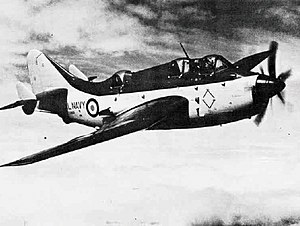Fairey Gannet
| Gannet | |
|---|---|
 |
|
| A Royal Navy Fairey Gannet AS.4 | |
| Role | Anti-submarine warfare aircraft |
| National origin | United Kingdom |
| Manufacturer | Fairey Aviation Company |
| Designer | H. E. Chaplin |
| First flight | 19 September 1949 |
| Introduction | 1953 |
| Retired | 15 December 1978 |
| Primary users |
Royal Navy Royal Australian Navy German Navy Indonesian Navy |
| Produced | 1953–1959 |
| Number built | 303 (Anti-submarine) 45 (Airborne early warning) |
| Variants | Fairey Gannet AEW.3 |
The Fairey Gannet was a British carrier-borne aircraft of the post-Second World War era developed for the Royal Navy's Fleet Air Arm (FAA) by the Fairey Aviation Company. It was a mid-wing monoplane with a tricycle undercarriage and a crew of three, and a double turboprop engine driving two contra-rotating propellers.
The Gannet was originally developed to meet the FAA's dual-role anti-submarine warfare and strike requirement. It was later adapted for operations as an electronic countermeasures and carrier onboard delivery aircraft. The Gannet AEW was a variant of the aircraft developed as a carrier-based airborne early warning platform.
The Gannet was built in response to the 1945 Admiralty requirement GR.17/45, for which prototypes by Fairey (Type Q or Fairey 17, after the requirement) and Blackburn Aircraft (the Blackburn B-54 / B-88) were built.
After considering and discounting the Rolls-Royce Tweed turboprop, Fairey selected an engine based on the Armstrong Siddeley Mamba: the Double Mamba (or "Twin Mamba"), basically two Mambas mounted side-by-side and coupled through a common gearbox to coaxial contra-rotating propellers. Power was transmitted from each engine by a torsion shaft which was engaged through a series of sun, planet, epicyclic and spur gears to give a suitable reduction ratio and correct propeller-shaft rotation.
...
Wikipedia
